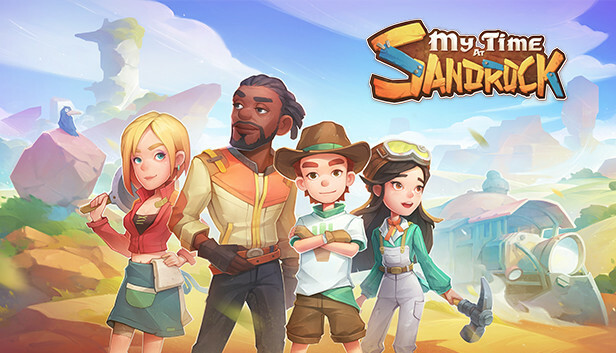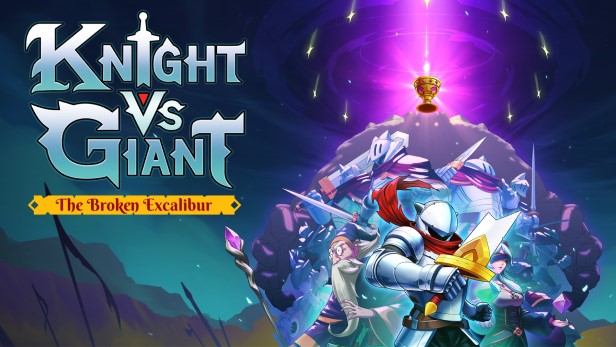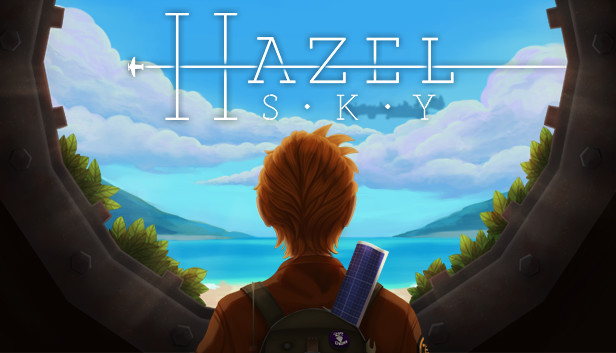
My Time at Sandrock – Analysis (Review)
March 22, 2024| GAME SHEET: Release: November 2, 2023 Players: 01 player Genre: Adventure, Casual, Indie, RPG, Simulation. Developer: Pathea Games Publisher: DMM Games, Pathea Games, PM Studios Available languages: German, Simplified Chinese, Traditional Chinese, Korean, Spanish, French, English, Italian, Japanese, Portuguese, Russian. Available on platforms: PC – Computer (Windows), Nintendo Switch, PlayStation 5, PlayStation 4, Xbox One, Xbox Series X|S. Rating: Free – Suitable for all ages. Game version analyzed: American version for PlayStation 5. |
From the moment I embarked on the adventure that is My Time at Sandrock, I knew I was about to live a unique experience. Since the first time (a few thousand years ago) that I played SimCity on the Super Nintendo and The Sims on the PC, I became a fan of life simulation games, with a special affection for the predecessor My Time at Portia, my expectations were high, but what I found surpassed them in every way. Let’s dive into this detailed analysis of one of the most captivating games I’ve had the pleasure of playing in recent memory.
Set in a post-apocalyptic context, where humanity struggles to rebuild what was lost, My Time at Sandrock puts us in the shoes of a builder tasked with bringing hope to a small desert town. With a vast setting to explore, memorable characters to meet and a multitude of activities to undertake, the game unfolds like a tapestry rich in details and possibilities.
Mechanics and Gameplay
The essence of My Time at Sandrock lies in its deeply satisfying gameplay loop. From collecting resources to building machines and structures, each action contributes to the development of the city and your own evolution as a builder. The diversity of tasks, which includes mining, farming, and even combat, although the latter has its limitations, ensures that there is always something new to do.
Interaction with the inhabitants of Sandrock is another pillar of the gameplay. Each character has their own story and personality, transforming construction missions and small favors into opportunities to deepen bonds and uncover secrets. The nuanced relationship system adds a rich layer to the experience, with romances and friendships that evolve organically.
Graphics
Sandrock’s setting, with its vast deserts, towering rock formations and occasional verdant oasis, is visually stunning. The development team has managed to create an atmosphere that simultaneously evokes the vastness and isolation of the desert, but also the hope and vitality of a community rebuilding. Day-to-night transitions and dynamic weather changes add layers of immersion, with elongated shadows at sunset and sandstorms that occasionally sweep across the landscape, offering a visual spectacle.
The graphics of “My Time at Sandrock” feature a vibrant color palette that highlights the diversity of the environment. Every element, from the prickly cacti to the ruins of ancient civilization, is rendered with a level of detail that invites exploration. This visual whimsy extends to the city of Sandrock, where western-style buildings, steam engines and futuristic constructions coexist harmoniously, reflecting the unique mix of past, present and future that characterizes the game.
In addition to the landscape and architecture, the character design is another highlight of the graphics. Each Sandrock inhabitant has a unique appearance, with lively facial expressions and clothing that reflects their personalities and life stories. Interaction with them is enriched by fluid animations that convey emotions and emphasize the vibrant character of the community.
However, not everything is perfect. At times, I encountered small technical issues, such as pop-ins and textures that took a long time to load, especially when exploring denser areas of the map or in quick transitions between different locations. While these setbacks don’t significantly compromise the overall experience, they are pointed reminders that the Sandrock Desert still has its technical mysteries to polish.
Sound
My Time at Sandrock’s soundtrack perfectly accompanies the game’s atmosphere, with melodies that evoke the serenity and mystery of the desert. The sound effects, from the noise of machines to the sounds of nature, immerse the player even more in the world. While the voice acting is variable, with some performances more convincing than others, it adds a layer of authenticity to the character interactions.
Fun
The true test of any game is how fun it is, and My Time at Sandrock passes with flying colors. There’s genuine joy in every discovery, whether it’s a new feature, a secret area, or a piece of a character’s history. The freedom to choose how to spend your days, whether focusing on building, exploration or social relationships, ensures that each player can create their own unique and rewarding experience.
Without a shadow of a doubt, My Time at Sandrock is one of those games that captivates and keeps the player engaged for hours on end, offering a deeply fun and satisfying experience. From the beginning of my journey in this vibrant post-apocalyptic world, I was sucked into a routine of building, exploring and interacting that rarely encountered moments of monotony or boredom.
What makes My Time at Sandrock especially fun is its richly designed gameplay loop. With each new day in the game, I was excited to plan my activities, whether it was advancing main quests, scavenging for resources, upgrading my machines, or building structures that benefit both me and the citizens of Sandrock. The sense of progress is palpable, watching the improvements in the city and on my own lot, and it’s incredibly rewarding.
Furthermore, the complexity and diversity of game mechanics add a layer of strategy that enriches the experience. Deciding which resources to prioritize, which parts of the city to restore first, or how to optimize production in my workshop are decisions that require thought and planning. This, combined with the trading system and daily quests, ensures that there are always objectives to achieve and rewards to obtain.
Interaction with Sandrock characters is another element that greatly contributes to the fun. Developing relationships, participating in social events and uncovering the personal stories of the city’s inhabitants are activities that have provided me with many memorable moments. Each character is unique, with their own personalities, desires, and problems, making each interaction feel meaningful.
On the other hand, while the combat system isn’t the game’s main focus, and can feel a little clunky or underdeveloped compared to other aspects of the game, it still offers a welcome change of pace. Facing desert creatures or exploring dangerous ruins adds an element of adventure and risk that complements the building and management routine well.
However, it is important to mention that, despite the good dose of fun provided, the game is not free from technical problems, which at times (even if rare) can hinder the experience. But overall, these issues weren’t enough to significantly diminish my enjoyment of the game.
Performance and Optimization
Playing My Time at Sandrock, I couldn’t help but notice some aspects related to performance and optimization that impacted, at certain times, my immersion in this vibrant desert world. While the game shines in many areas, these optimization issues are worth highlighting so future players know what they can expect and so developers can target improvements in future updates.
From the beginning, one of the most obvious problems was the pop-in of textures and objects. When exploring the vast landscapes of Sandrock, objects, NPCs and even entire buildings suddenly appeared in my field of vision, breaking the fluidity of exploration. While this is common in open-world games, the frequency with which it occurred was notable, especially when quickly traveling through different areas of the map.
Additionally, I encountered issues related to the frames per second (fps) rate. In densely populated areas or during events with many elements on screen, such as festivals or large gatherings of NPCs, performance suffered significant drops in fps, resulting in less fluid gameplay. These slowdowns weren’t constant, but when they occurred, they made the experience less pleasant.
Loading times also presented an inconsistency that deserves to be mentioned. Although at times the game loaded new areas quickly, at others I faced long wait times, especially when entering buildings or starting mining sessions. These pauses in the game’s pace affected the dynamism of the gameplay, especially when I was immersed in task sequences or exploration.
Another aspect that captured my attention was the occurrence of bugs and glitches. While many were minor and more of a quirk than a problem — like NPCs acting unexpectedly or small objects floating above the ground — others were more disruptive. On rare occasions, I found myself unable to interact with certain objects or complete tasks due to these bugs, requiring me to restart the game to resolve the situation.
Finally, the user interface (UI) and user experience (UX) in certain parts of the game seemed to need additional refinement to improve navigation and interaction. Although the general design of the UI is intuitive, in moments of intensive resource management or during construction, I missed a more efficient organization that could facilitate access and visualization of the necessary information.
Although My Time at Sandrock offers a rich and immersive gaming experience, these performance and optimization issues are aspects that, if addressed, could further elevate the quality of the title. I trust that with time and community feedback, the developers will continue to polish and optimize the game, improving these technical aspects to ensure that players can fully enjoy the beauty and depth of Sandrock without interruption.
Conclusion
My Time at Sandrock is an unforgettable journey that captivates from the first moment. With rich gameplay, a beautifully constructed world and a well-constructed community of characters suited to the game’s proposal, it offers a deeply satisfying and diverse experience. Despite some technical problems and a combat system that could be more elaborate, the game stands out as a masterpiece in the life simulation genre. I warmly recommend it to anyone looking for an immersive experience that challenges both creativity and the heart.
My Time at Sandrock is, without a doubt, a game that I highly recommend. It is a work that transcends simple entertainment, touching the heart and awakening the imagination. If you’re looking for an adventure that offers more than just challenges and rewards, but rather an enriching and memorable journey, this is the game for you. Engage, explore, build, and most of all, live the life you choose in Sandrock. One thing is certain: whatever path you take, it will be an unforgettable experience.
Strengths:
- Rich Gameplay Loop : Deep integration between gathering, building, and social interaction creates an engaging and varied gameplay loop.
- Vibrant and Detailed World : The game’s visual design is stunning, with a world rich in color and detail that invites exploration.
- Memorable Characters : The diversity and depth of Sandrock’s inhabitants add a rich layer of narrative and emotion to the game.
- Freedom of Choice : The wide range of activities and the freedom to approach them according to the player’s desire guarantee a personalized and diverse experience.
Negative points:
- Underdeveloped Combat : The combat system is basic and less engaging compared to other aspects of the game.
- Technical Issues : Occasional bugs and optimization issues can interrupt immersion, although they are generally minor.
Rating:
Graphics : 9.0 – The game shines with its captivating visuals and attention to detail.
Fun : 9.5 – Few games offer such a rich and varied experience, guaranteeing hours of fun.
Gameplay : 8.5 – With one exception made for combat, the gameplay is engaging and satisfying.
Sound : 8.0 – A charming soundtrack and immersive sound effects, despite variable voice acting.
Performance and Optimization : 7.5 – Technical and optimization problems mark negative points, but do not compromise the experience as a whole.
FINAL GRADE: 8.5 / 10.0
![Revolution Arena [English Version]](https://revolutionarena.com/english/wp-content/uploads/sites/4/2024/07/Revolution-Arena-ISSN-2966-2117.png)


Facebook Comments